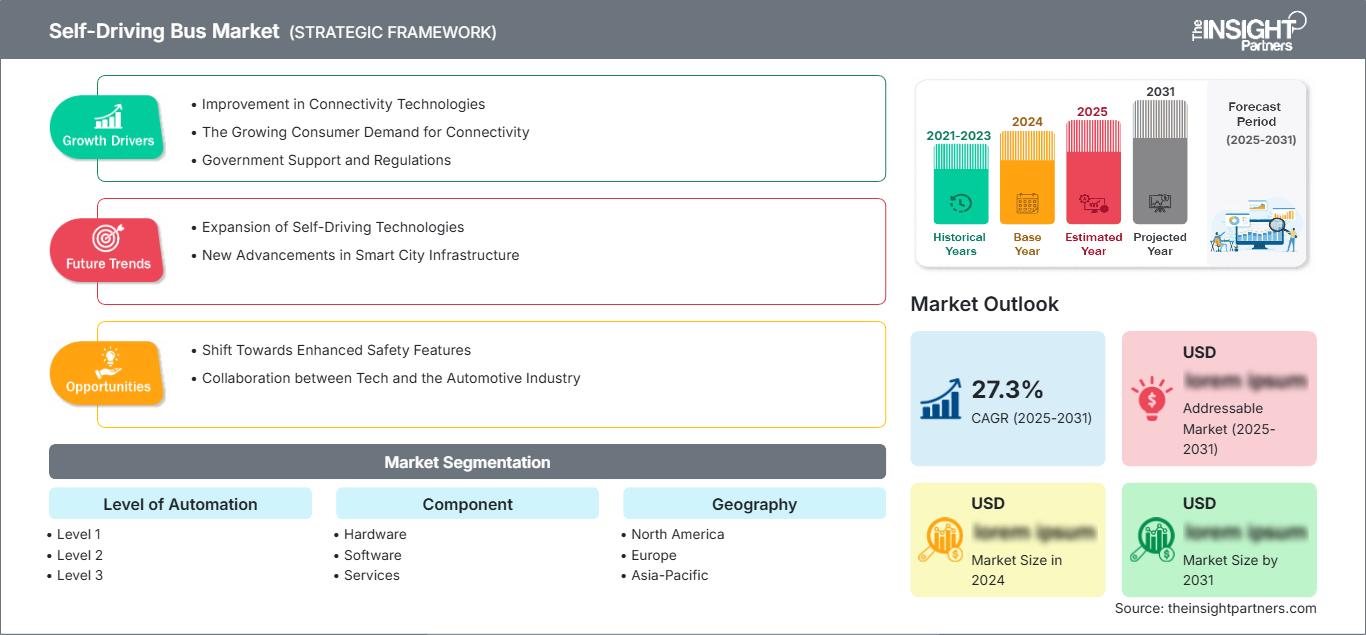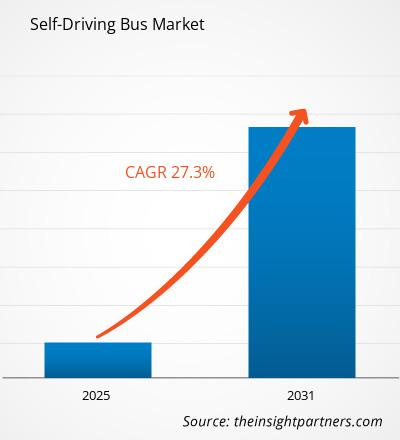Der Markt für selbstfahrende Busse wird voraussichtlich zwischen 2025 und 2031 eine durchschnittliche jährliche Wachstumsrate (CAGR) von 27,3 % verzeichnen, wobei die Marktgröße von XX Millionen US-Dollar im Jahr 2024 auf XX Millionen US-Dollar im Jahr 2031 anwachsen wird.
Der Bericht ist nach Automatisierungsgrad (Level 1, Level 2, Level 3, Level 4, Level 5) und Komponenten (Hardware, Software, Services) segmentiert. Die globale Analyse ist weiter nach Regionen und wichtigen Ländern aufgeschlüsselt. Der Bericht bietet den Wert in USD für die obige Analyse und Segmentierung.
Zweck des Berichts
Der Bericht „Markt für selbstfahrende Busse“ von The Insight Partners zielt darauf ab, die aktuelle Situation und das zukünftige Wachstum sowie die wichtigsten treibenden Faktoren, Herausforderungen und Chancen zu beschreiben. Dies bietet verschiedenen Geschäftspartnern Einblicke, wie beispielsweise:
- Technologieanbieter/-hersteller: Um die sich entwickelnde Marktdynamik zu verstehen und die potenziellen Wachstumschancen zu kennen, damit sie fundierte strategische Entscheidungen treffen können.
- Investoren: Um eine umfassende Trendanalyse hinsichtlich der Marktwachstumsrate, der finanziellen Marktprognosen und der Chancen entlang der Wertschöpfungskette durchzuführen.
- Regulierungsbehörden: Um Richtlinien und Überwachungsaktivitäten auf dem Markt zu regulieren, mit dem Ziel, Missbrauch zu minimieren, das Vertrauen der Investoren zu wahren und die Integrität und Stabilität des Marktes aufrechtzuerhalten.
Marktsegmentierung für selbstfahrende Busse – Automatisierungsgrad
- Stufe 1
- Stufe 2
- Stufe 3
- Stufe 4
- Stufe 5
Komponente
- Hardware
- Software
- Dienste
Sie erhalten kostenlos Anpassungen an jedem Bericht, einschließlich Teilen dieses Berichts oder einer Analyse auf Länderebene, eines Excel-Datenpakets sowie tolle Angebote und Rabatte für Start-ups und Universitäten.
Markt für selbstfahrende Busse: Strategische Einblicke

- Holen Sie sich die wichtigsten Markttrends aus diesem Bericht.Dieses KOSTENLOSE Beispiel umfasst Datenanalysen, die von Markttrends bis hin zu Schätzungen und Prognosen reichen.
Wachstumstreiber für den Markt für selbstfahrende Busse
- Verbesserung der Konnektivitätstechnologien: Das Wachstum des Marktes für selbstfahrende Busse wird durch die rasante Weiterentwicklung der Konnektivitätstechnologien vorangetrieben, darunter 4G-, LTE- und bald auch 5G-Netze. Diese Verbesserungen ermöglichen es Fahrzeugen, miteinander und mit der Infrastruktur zu kommunizieren, um ein besseres Fahrerlebnis zu bieten, die Sicherheit zu gewährleisten und die Straßennavigation zu verbessern.
- Die wachsende Verbrauchernachfrage nach Konnektivität: Verbraucher bevorzugen zunehmend Fahrzeuge mit Konnektivitätstechnologien. Fahrzeuge mit umfangreichen Konnektivitätsoptionen erfreuen sich bei den Kunden großer Beliebtheit. Fahrer suchen nach Bordunterhaltung, Navigation und Sicherheitslösungen, die auf Echtzeitdaten und Internetkonnektivität basieren.
- Staatliche Unterstützung und Vorschriften: Viele Regierungen weltweit investieren in Smart-City-Initiativen und erlassen günstige Vorschriften zur Unterstützung autonomer Fahrzeuge. Eine Politik, die ein förderliches Umfeld für Innovationen schafft, insbesondere in den Bereichen Transporttechnologien und selbstfahrende Busse, fördert das Marktwachstum und die Infrastruktur für autonome Lösungen.
Zukünftige Trends im Markt für selbstfahrende Busse
- Ausbau selbstfahrender Technologien: Die Kombination von Technologien für vernetzte Fahrzeuge mit autonomen Fahrsystemen kann neue Möglichkeiten eröffnen. Mit dem Einstieg der Branche in den Bereich vollautonomer Fahrzeuge steigt der Bedarf an guten Konnektivitätslösungen. Dies ermöglicht sicherere und effizientere Fahrzeiten. Unternehmen, die in diesem Bereich investieren, können vom rasant zunehmenden Trend zur Automatisierung profitieren.
- Neue Fortschritte in der Smart-City-Infrastruktur: Vernetzte Busse versprechen Städten im Zusammenspiel mit der städtischen Infrastruktur hervorragende Möglichkeiten. Diese Infrastruktur umfasst Verkehrsmanagementsysteme, Parklösungen und Transportnetze für öffentliche Straßenfahrzeuge. Die Zusammenarbeit zwischen Automobilherstellern und Stadtplanern kann zu neuen Lösungen führen, die die Mobilität der Menschen in Städten verbessern und staufreier gestalten.
Marktchancen für selbstfahrende Busse
- Trend zu verbesserten Sicherheitsfunktionen: Trends bei besseren Sicherheitsfunktionen – Verstärkter Einsatz fortschrittlicher Sicherheitslösungen in vernetzten Fahrzeugen Verbesserte Sicherheitsfunktionen liegen im Trend. Kollisionsvermeidungssysteme, Echtzeit-Verkehrsinformationen und Notfallreaktionsfunktionen gehören automatisch zur Standardausstattung neuer Modelle. Dadurch wird eine bessere Einhaltung von Vorschriften und Verbraucherbedenken gewährleistet, was zu einer deutlich breiteren Akzeptanz vernetzter Technologien führt.
- Zusammenarbeit zwischen Technologie- und Automobilindustrie: Es gibt einen wachsenden Trend zur Zusammenarbeit zwischen Technologieunternehmen und Automobilherstellern bei der Entwicklung autonomer Fahrsysteme für Busse. Unternehmen wie Waymo, Tesla und traditionelle Bushersteller arbeiten zusammen, um die Einführung selbstfahrender Busse zu beschleunigen und die Grenzen der Fahrzeugautomatisierung zu erweitern.
Markt für selbstfahrende Busse
Die Analysten von The Insight Partners haben die regionalen Trends und Faktoren, die den Markt für selbstfahrende Busse im Prognosezeitraum beeinflussen, ausführlich erläutert. In diesem Abschnitt werden auch die Marktsegmente und die geografische Lage für selbstfahrende Busse in Nordamerika, Europa, im asiatisch-pazifischen Raum, im Nahen Osten und Afrika sowie in Süd- und Mittelamerika erörtert.Umfang des Marktberichts zum Thema selbstfahrende Busse
| Berichtsattribut | Einzelheiten |
|---|---|
| Marktgröße in 2024 | US$ XX million |
| Marktgröße nach 2031 | US$ XX Million |
| Globale CAGR (2025 - 2031) | 27.3% |
| Historische Daten | 2021-2023 |
| Prognosezeitraum | 2025-2031 |
| Abgedeckte Segmente |
By Automatisierungsgrad
|
| Abgedeckte Regionen und Länder | Nordamerika
|
| Marktführer und wichtige Unternehmensprofile |
|
Dichte der Marktteilnehmer für selbstfahrende Busse: Auswirkungen auf die Geschäftsdynamik verstehen
Der Markt für selbstfahrende Busse wächst rasant. Die steigende Nachfrage der Endnutzer ist auf Faktoren wie veränderte Verbraucherpräferenzen, technologische Fortschritte und ein stärkeres Bewusstsein für die Produktvorteile zurückzuführen. Mit der steigenden Nachfrage erweitern Unternehmen ihr Angebot, entwickeln Innovationen, um den Bedürfnissen der Verbraucher gerecht zu werden, und nutzen neue Trends, was das Marktwachstum weiter ankurbelt.

- Holen Sie sich die Markt für selbstfahrende Busse Übersicht der wichtigsten Akteure
Wichtige Verkaufsargumente
- Umfassende Abdeckung: Der Bericht analysiert umfassend Produkte, Dienstleistungen, Typen und Endnutzer des Marktes für selbstfahrende Busse und bietet einen ganzheitlichen Überblick.
- Expertenanalyse: Der Bericht basiert auf dem umfassenden Verständnis von Branchenexperten und Analysten.
- Aktuelle Informationen: Der Bericht gewährleistet Geschäftsrelevanz durch die Berichterstattung über aktuelle Informationen und Datentrends.
- Anpassungsoptionen: Dieser Bericht kann an spezifische Kundenanforderungen angepasst werden und passt sich optimal an die Geschäftsstrategien an.
Der Forschungsbericht zum Markt für selbstfahrende Busse kann daher dazu beitragen, die Branchensituation und die Wachstumsaussichten zu entschlüsseln und zu verstehen. Obwohl es einige berechtigte Bedenken geben mag, überwiegen die Vorteile dieses Berichts tendenziell die Nachteile.
- Historische Analyse (2 Jahre), Basisjahr, Prognose (7 Jahre) mit CAGR
- PEST- und SWOT-Analyse
- Marktgröße Wert/Volumen – Global, Regional, Land
- Branchen- und Wettbewerbslandschaft
- Excel-Datensatz
Aktuelle Berichte
Erfahrungsberichte
Grund zum Kauf
- Fundierte Entscheidungsfindung
- Marktdynamik verstehen
- Wettbewerbsanalyse
- Kundeneinblicke
- Marktprognosen
- Risikominimierung
- Strategische Planung
- Investitionsbegründung
- Identifizierung neuer Märkte
- Verbesserung von Marketingstrategien
- Steigerung der Betriebseffizienz
- Anpassung an regulatorische Trends




















 Kostenlose Probe anfordern für - Markt für selbstfahrende Busse
Kostenlose Probe anfordern für - Markt für selbstfahrende Busse